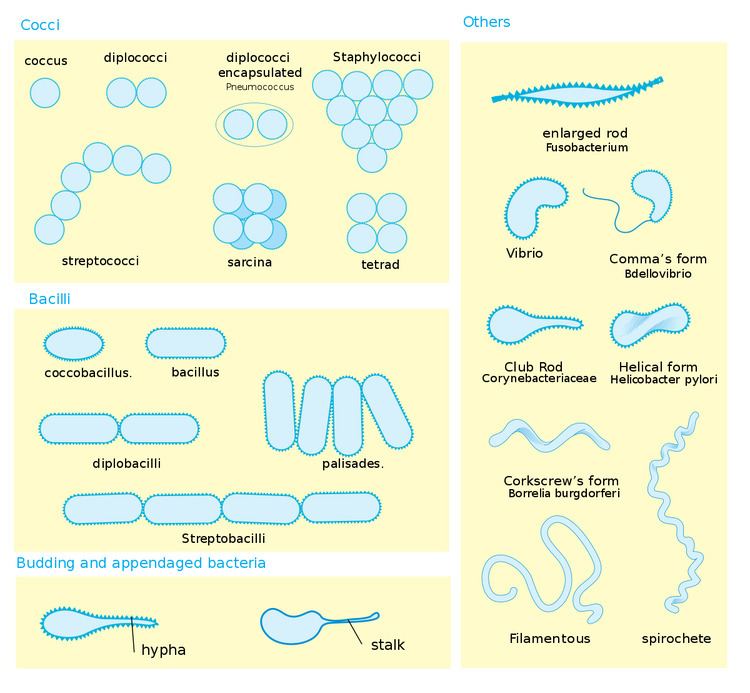 | ||
Bacteria are classified by direct examination with the light microscope through its morphology and aggregation.
Contents
The basic forms are spheres (coccus) and round-ended cylinders (bacillus). But there may be others such as helically twisted cylinders (spirochetes), cylinders curved in one plane (Selenomonads) and unusual morphologies (such as the square Archaea Haloquadratum). They also conform diplos, tetrads, staphylos, streptos, palizadas etc.
Coccus
A coccus (plural cocci, from the Latin coccinus (scarlet) and derived from the Greek kokkos (berry)) is any microorganism (usually bacteria) whose overall shape is spherical or nearly spherical. Describing a bacterium as a coccus, or sphere, distinguishes it from bacillus, or rod. This is the first of many taxonomic traits for identifying and classifying a bacterium according to binomial nomenclature.
Aggregations
Aggregations of coccoid bacteria often occur and these forms have specific names as well; listed here are the basic forms as well as representative bacterial genera:
Diplococcus
A diplococcus (plural diplococci) is a round bacterium (a coccus) that typically occurs in pairs of two joined cells. Examples are Streptococcus pneumoniae, Moraxella catarrhalis, Neisseria gonorrhoeae and Neisseria meningitidis.
Its name comes from diplo, meaning double, and coccus, meaning berry. This is because berries are round, like a diplococcus, and diplococci come in pairs of two.
In former times, a bacterial genus Diplococcus was recognized, but it is not used anymore.
Coccobacillus
A coccobacillus (plural coccobacilli) is a type of rod-shaped bacteria. The word coccobacillus reflects an intermediate shape between coccus (spherical) and bacillus (elongated). Coccobacilli rods are so short and wide that they resemble cocci. Haemophilus influenzae and Chlamydia trachomatis are coccobacilli. Aggregatibacter actinomycetemcomitans is a gram negative coccobacillus which is prevalent in subgingival plaques. Acinetobacter strains may grow on solid media as coccobacilli.
Coxiella burnetti is also a coccobacillus.
Clinical significance
Important human pathogens caused by coccoid bacteria those include staphylococci infections, some types of food poisoning, some urinary tract infections, toxic shock syndrome, gonorrhea, as well as some forms of meningitis, throat infections, pneumonias, and sinusitis.
Bacillus
A bacillus (plural bacilli) is a rod-shaped bacterium. Although Bacillus, capitalized and italicized, specifically refers to the genus, the word bacillus (plural bacilli) may also be used to describe any rod-shaped bacterium, and in this sense, bacilli are found in many different taxonomic groups of bacteria. There is no connection between the shape of a bacterium and its colors in the Gram staining.
Bacilli usually divide in the same plane and are solitary, but can combine to form diplobacilli, streptobacilli, and palisades.
Spiral
Spiral bacteria form the third major bacterial cell morphology. Spiral bacteria can be sub-classified as spirilla, spirochetes, or vibrios based on the number of twists per cell, cell thickness, cell flexibility, and motility.
